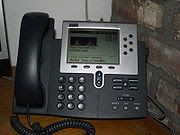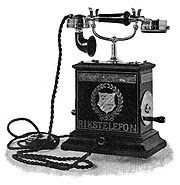Sunday, August 23, 2009
Cell-phone Frequencies
The genius of the cellular system is the division of a city into small cells. This allows extensive frequency reuse across a city, so that millions of people can use cell phones simultaneously.
A good way to understand the sophistication of a cell phone is to compare it to a CB radio or a walkie-talkie.
Full-duplex vs. half-duplex - Both walkie-talkies and CB radios are half-duplex devices. That is, two people communicating on a CB radio use the same frequency, so only one person can talk at a time. A cell phone is a full-duplex device. That means that you use one frequency for talking and a second, separate frequency for listening. Both people on the call can talk at once.
Channels - A walkie-talkie typically has one channel, and a CB radio has 40 channels. A typical cell phone can communicate on 1,664 channels or more!
Range - A walkie-talkie can transmit about 1 mile (1.6 km) using a 0.25-watt transmitter. A CB radio, because it has much higher power, can transmit about 5 miles (8 km) using a 5-watt transmitter. Cell phones operate within cells, and they can switch cells as they move around. Cells give cell phones incredible range. Someone using a cell phone can drive hundreds of miles and maintain a conversation the entire time because of the cellular approach.
In half-duplex radio, both transmitters use the same frequency. Only one party can talk at a time.
In full-duplex radio, the two transmitters use different frequencies, so both parties can talk at the same time.Cell phones are full-duplex.
How Cell Phones Work
These days, cell phones provide an incredible array of functions, and new ones are being added at a breakneck pace. Depending on the cell-phone model, you can:
Store contact information
Make task or to-do lists
Keep track of appointments and set reminders
Use the built-in calculator for simple math
Send or receive e-mail
Get information (news, entertainment, stock quotes) from the Internet
Play games
Watch TV
Send text messages
Integrate other devices such as PDAs, MP3 players and GPS receivers Explore Cell PhonesiPhoneCell Phone Quiz10 Popular PhonesDiscovery.com: Cell Phone Users Tracked -->
Use of Mobile Phone in Schools
Mobile phones and driving safety
Software and Applications of Cell Phone
The other non-SMS data services used by mobile phones were worth 31 Billion dollars in 2007, and were led by mobile music, downloadable logos and pictures, gaming, gambling, adult entertainment and advertising (source: Informa 2007). The first downloadable mobile content was sold to a mobile phone in Finland in 1998, when Radiolinja (now Elisa) introduced the downloadable ringing tone service. In 1999 Japanese mobile operator NTT DoCoMo introduced its mobile internet service, i-Mode, which today is the world's largest mobile internet service and roughly the same size as Google in annual revenues.
The first mobile news service, delivered via SMS, was launched in Finland in 2000. Mobile news services are expanding with many organisations providing "on-demand" news services by SMS. Some also provide "instant" news pushed out by SMS. Mobile telephony also facilitates activism and public journalism being explored by Reuters and Yahoo![14] and small independent news companies such as Jasmine News in Sri Lanka.
Handsets
History of mobile phones
In the beginning, two-way radios (known as mobile rigs) were used in vehicles such as taxicabs, police cruisers, ambulances, and the like, but were not mobile phones because they were not normally connected to the telephone network. Users could not dial phone numbers from their vehicles. A large community of mobile radio users, known as the mobileers, popularized the technology that would eventually give way to the mobile phone. Originally, mobile phones were permanently installed in vehicles, but later versions such as the so-called transportables or "bag phones" were equipped with a cigarette lighter plug so that they could also be carried, and thus could be used as either mobile or as portable two-way radios. During the early 1940s, Motorola developed a backpacked two-way radio, the Walkie-Talkie and later developed a large hand-held two-way radio for the US military. This battery powered "Handie-Talkie" (HT) was about the size of a man's forearm.
In Europe, radio telephony was first used on the first-class passenger trains between Berlin and Hamburg in 1926. At the same time, radio telephony was introduced on passenger airplanes for air traffic security. Later radio telephony was introduced on a large scale in German tanks during the Second World War. After the war German police in the British zone of occupation first used disused tank telephony equipment to run the first radio patrol cars.[citation needed] In all of these cases the service was confined to specialists that were trained to use the equipment. In the early 1950s ships on the Rhine were among the first to use radio telephony with an untrained end customer as a user.
Recording units connected to handset wire
Typically the handset of the telephone is connected to the base of the telephone using 4 wire connector. Two of those wires carry the signals to the handset spaker and two other wires on the other side of the connector carry the microphone signals. The standard handser wiring used in telephone in USA has Green and White leads connected to earpiece and Black and Red wires are connected to microphone.
There are differences on the signal levels used by deferent telephones, so typically the equipment which connect to handset connector have some adjustments to make them suit to many telephone types. Well adjusted recording interface which is connected to handset interface gives good balance between the local voice and voice from distant end (much better than recording devices which connect to telephone line).
Telephone line current sensing method
Tape <==== Relay Contacts
Recorder <------------------o/ o
mmmmm DC 3v 20 mA Relay Coil
Line >------------------------+---+----------> To Phone
47 uF Capacitor
Line >-----------------------------------------> To Phone
Recording of telephone conversations
The adapter has two functions: it connects the audio from telephone line to recorder input at correct leveal and it isolates the recorder electrically from telephone line. The isolation is very important part of the adapter, because connecting tape recorder directly to the telephone line is against telephone regulations, causes all kinds of noises to telephone line and will damage your recorder. Some adapters have also tape recorder controlling function enabling recorder to start automatically when phone is picked up and stop when phone conversation ends.
Main parts of Telephone
Very large image demonstrating how a telephone works
Modern telephones don't use carbon in their handsets. They use electret microphones for the transmitter and piezoelectric transducers for receivers but the principle described in the image linked above is the same. Sound waves picked up by an electret microphone causes "a thin, metal-coated plastic diaphragm to vibrate, producing variations in an electric field across a tiny air gap between the diaphragm and an electrode."[Britannica definition] A piezoelectric transducer uses material which converts the mechanical stress of a sound wave upon it into a varying electrical signal.
Telephone history begins at the start of human history. Man has always wanted to communicate from afar. People have used smoke signals, mirrors, jungle drums, carrier pigeons and semaphores to get a message from one point to another. But a phone was something new. Some say Francis Bacon predicted the telephone in 1627, however, his book New Utopia only described a long speaking tube. A real telephone could not be invented until the electrical age began. And even then it didn't seem desirable. The electrical principles needed to build a telephone were known in 1831 but it wasn't until 1854 that Bourseul suggested transmitting speech electrically. And it wasn't until 22 years later in 1876 that the idea became a reality. But before then, a telephone might have been impossible to form in one's consciousness.
Bell's Telephone
Bell imagined great uses for his telephone, like this model from the 1920s, but would he ever have imagined telephone lines being used to transmit video images? Since his death in 1922, the telecommunication industry has undergone an amazing revolution. Today, non-hearing people are able to use a special display telephone to communicate. Fiber optics are improving the quality and speed of data transmission. Actually, your ability to access this information relies upon telecommunications technology. Bell's "electrical speech machine" paved the way for the Information Superhighway.
Alexander Graham Bell - Evolution of the Telegraph into the Telephone
When Bell began experimenting with electrical signals, the telegraph had been an established means of communication for some 30 years. Although a highly successful system, the telegraph, with its dot-and-dash Morse code, was basically limited to receiving and sending one message at a time. Bell's extensive knowledge of the nature of sound and his understanding of music enabled him to conjecture the possibility of transmitting multiple messages over the same wire at the same time. Although the idea of a multiple telegraph had been in existence for some time, Bell offered his own musical or harmonic approach as a possible practical solution. His "harmonic telegraph" was based on the principle that several notes could be sent simultaneously along the same wire if the notes or signals differed in pitch.
The History of the Telephone - Alexander Graham Bell
Thursday, July 9, 2009
Telephone operating companies
IP telephony
IP telephony uses an Internet connection and hardware IP Phones or softphones installed on personal computers to transmit conversations encoded as data packets. In addition to replacing POTS (plain old telephone service), IP telephony services are also competing with mobile phone services by offering free or lower cost connections via WiFi hotspots. VoIP is also used on private networks which may or may not have a connection to the global telephone network.
IP telephones have two notable disadvantages compared to traditional telephones. Unless the IP telephone's components are backed up with an uninterruptible power supply or other emergency power source, the phone will cease to function during a power outage as can occur during an emergency or disaster, exactly when the phone is most needed. Traditional phones connected to the older PSTN network do not experience that problem since they are powered by the telephone company's battery supply, which will continue to function even if there's a prolonged power black-out. A second distinct problem for an IP phone is the lack of a 'fixed address' which can impact the provision of emergency services such as police, fire or ambulance, should someone call for them. Unless the registered user updates the IP phone's physical address location after moving to a new residence, emergency services can be, and have been, dispatched to the wrong location
Wednesday, July 1, 2009
Telephone
Digital telephony
IP telephony
Hardware-based IP phone
Internet Protocol (IP) telephony (also known as Voice over Internet Protocol, VoIP), is a disruptive technology that is rapidly gaining ground against traditional telephone network technologies. As of January 2005, up to 10% of telephone subscribers in Japan and South Korea have switched to this digital telephone service. A January 2005 Newsweek article suggested that Internet telephony may be "the next big thing."[1] As of 2006 many VoIP companies offer service to consumers and businesses.
IP telephony uses an Internet connection and hardware IP Phones or softphones installed on personal computers to transmit conversations encoded as data packets. In addition to replacing POTS (plain old telephone service), IP telephony services are also competing with mobile phone services by offering free or lower cost connections via WiFi hotspots. VoIP is also used on private networks which may or may not have a connection to the global telephone network.

